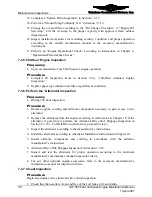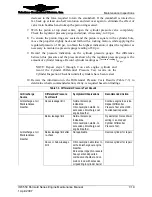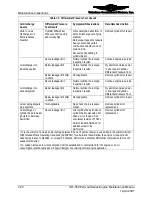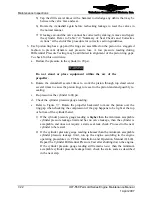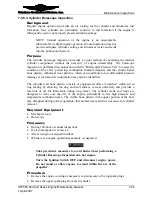
Teledyne Continental Motors, Inc.
TM
Maintenance
Inspections
IOF-550 Permold Series Engine Maintenance Manual
7-13
1 April 2007
•
Oil becoming discolored within first 10 hours after an oil change.
•
High iron content in oil analysis may be an indication.
•
Broken piston rings:
•
Scored, grooved cylinder; wall, evident via a borescope inspection.
•
Abnormal debris in oil filter or oil screen.
•
High iron content in oil analysis may be an indication.
•
Burned valves:
•
Usually results in differential leak test reading in the 0/80 to 40/80 range.
•
Easily identifiable during borescope inspection.
Additionally, many variables affect what a technician sees from a Differential Pressure
Test reading. These variables include, but are not limited to the following:
•
Abnormal amounts of oil in the cylinder.
•
Engine Temperature and cylinder temperature uniformity at the time the Differential
Pressure Test is performed.
•
Test equipment accuracy.
•
Capacity and quality of the compressed air source and the techniques used by the
technician when performing the test.
Test Equipment
•
Dry, oil-free compressed air source capable of providing a minimum line pressure of
125 P.S.I. with a minimum flow capability of 15 Cubic Feet per Minute.
•
Cylinder Differential Pressure Tester. Select one of the following units listed below
or equivalent:
•
Eastern Technology Corporation Model E2M (Figure 7-2) (Recommended by
TCM). This Differential Pressure Tester incorporates the Master Orifice Tool
(Figure 7-4).
•
Eastern Technology Corporation Model E2A (Figure 7-3). This Differential
Pressure Tester requires the purchase of a separate Master Orifice Tool with
Master Orifice Tool (TCM part number 646953A) (Figure 7-4)
WARNING
Failure to properly maintain and calibrate the Differential
Pressure Tester may result in misleading or erroneous
Differential Pressure Test readings.
NOTE: Differential pressure test equipment must be certified and
calibrated. Failure to properly maintain and calibrate test
equipment may result in false cylinder differential compression
readings.
Prior to conducting a Cylinder Differential Pressure Test, use the Master Orifice Tool to
normalize Differential Pressure Test readings and calibrate test equipment to ensure
accurate results according to Section 7-3.8.2.1 or 7-3.8.2.2.
Perform the Cylinder Differential Pressure Test as soon as possible after the aircraft has
flown. If the aircraft cannot be flown prior to performing the Cylinder Differential
Pressure Test, operate it on the ground, with the cowling installed until a minimum










